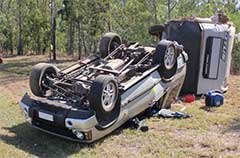 Have
your say
Have
your say
REPORTS and comments on caravan rollovers grow as general media
increasingly highlights their occurrence.
Just how many is unknown, but major insurer CIL Insurance alone reported
it had 135 claims in 2013.
It noted that 91 percent were caused by loss of driver control.
Does this imply that the drivers involved were incompetent, or that there
were issues with their towing equipment or that they were speeding ... or
some other contributing factor?
Any towed with a hitch at some distance behind the rear axle of the tow
vehicle is fundamentally unstable.
It can be made reasonably safe by keeping it short and light relative to
the tow vehicle and designed and laden so that mass is centralised with
axle/s positioned such that the front end is heavy.
That front end weight must not be obtained, however, by mass at the front
end (such as batteries and gas bottles).
Typical EU 'vans are designed as above.
Most are about 40 percent lighter per metre than most local products.
Most have less than half of Australia's tow ball weight.
 Meanwhile, locally designed 'vans are increasingly longer and heavier,
despite tow vehicles becoming increasingly lighter.
Meanwhile, locally designed 'vans are increasingly longer and heavier,
despite tow vehicles becoming increasingly lighter.
Some, such as the Land Rover/Range Rover, by half a tonne or so.
Even the new big US Fords are much lighter.
It can be argued (and I do) that part of the problem is that "recommended"
caravan/tow vehicle weight ratios are based on weight alone.
This is a pragmatic approach but a contradiction of basic mechanics.
It ignores that the effect of trailer weight on stability is related more
to the length of a trailer and where weight is located along it, than the
weight itself.
As the heavier camper trailers demonstrate, a 14ft 2000kg trailer is more
stable than a 22ft 2000kg caravan.
For those interested, my article
Caravan
Dynamics shows why.
Most existing recommendations stem from the 1930s when the typical caravan
was less than 1000kg, 12-15ft long and rarely towed at over 80km/h.
Recent UK and German recommendations are now far more stringent.
The engineer-run Caravan Council of Australia's 2013 recommendations are
less so, but were initially scorned by many local caravanners.
Currently, much faith is being placed on European and American electronic
systems aimed at detecting potentially dangerous sway and braking the
trailer accordingly.
This may well assist but is being seen as the solution rather than, as in
Europe, an additional safeguard for caravans that are already as stable as
feasible to make them.
Aircraft have such systems too, but they are designed to be as stable as
they can possibly be regardless.
The cause of jackknifing and rollover is usually speed-related.
For any combination of laden trailer and laden tow vehicle a sufficiently
strong disturbing side force (a very strong wind gust or emergency swerve
for instance) may jackknife the rig.
Above a critical speed (specific to each combination of trailer and tow
vehicle and their loading) that sufficiently disturbing force will
jackknife the rig.
Driver correction is impossible as the rig is triggered into
non-predictable chaotic behaviour.
Assessing that critical speed now seems theoretically feasible but
requires data relating to so-called "yaw inertia" that local caravan
makers (with the probable exception of Bailey) appear not to have.
Several I have approached did not what yaw inertia meant.
I seriously believe that unless this issue is addressed at industry level,
caravan rollovers will increase.
Further, local buyers will switch increasingly to imported or locally-made
EU-designed products.
A major user problem in getting this taken seriously is that the long, end
heavy caravans most at risk normally feel rock steady at any speed.
But the forces that make that so are the same forces that are its undoing
in emergency avoidance situations.
The very first comment following a jackknife is typically: "It had always
felt so stable until then."







 Meanwhile, locally designed 'vans are increasingly longer and heavier,
despite tow vehicles becoming increasingly lighter.
Meanwhile, locally designed 'vans are increasingly longer and heavier,
despite tow vehicles becoming increasingly lighter. 


